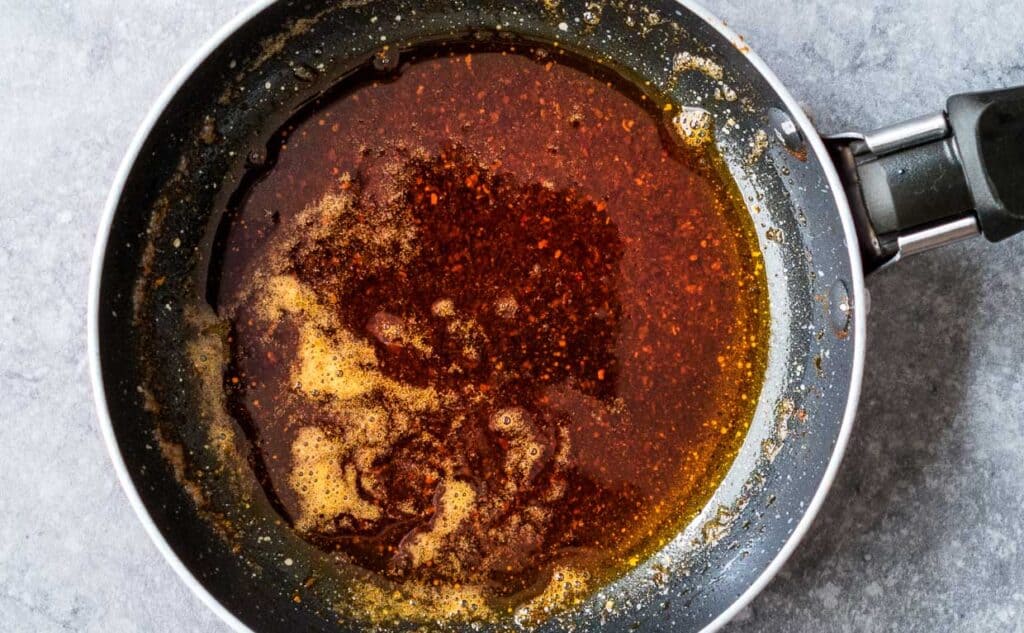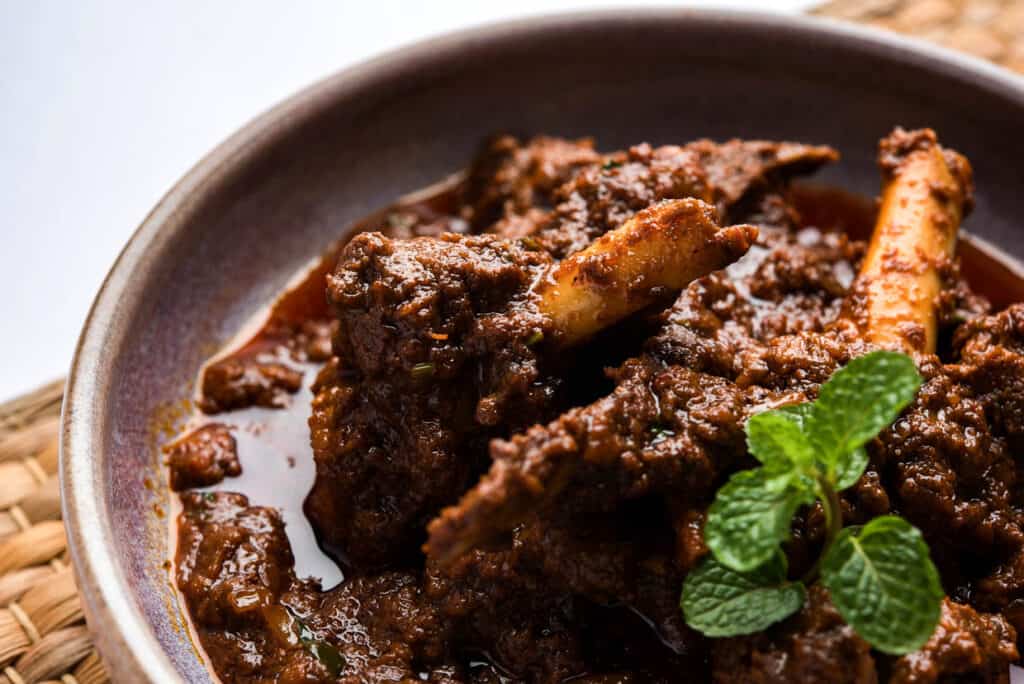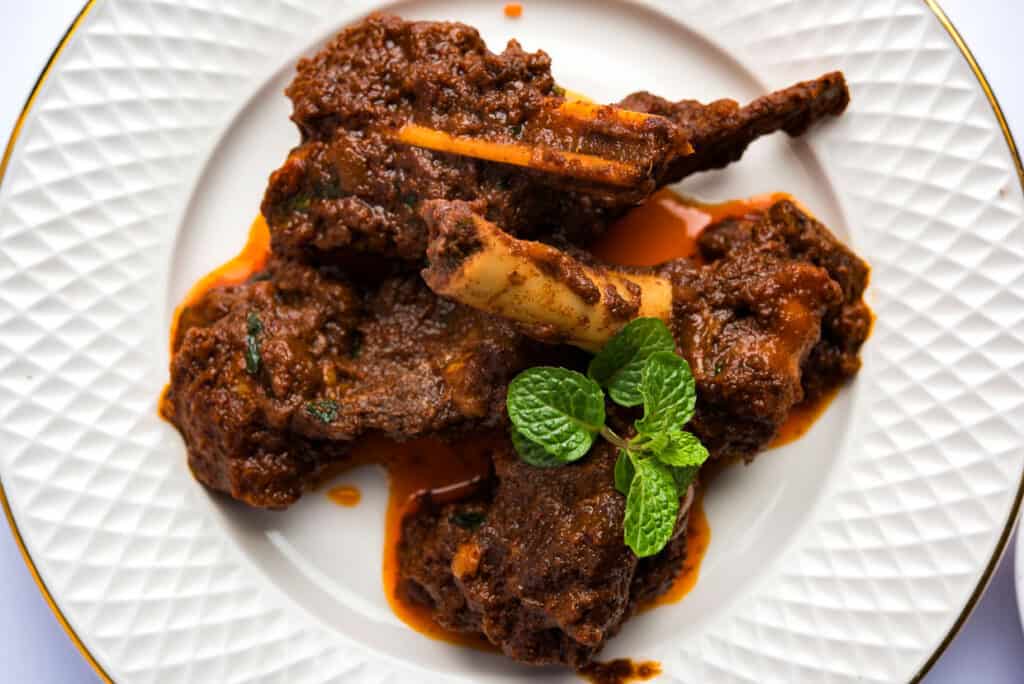Bhuna — one of Indian cuisine’s most intriguing exploits — is a method of frying spices in sizzling hot oil until they release their flavors and form a paste. The mixture is then used for slow-cooking meat and vegetables in a way that develops an intense, rich flavor. It’s a lesson in patience and the alchemy of spices.

Picture a saucepan sizzling and releasing the heady aroma of toasting spices — cumin, coriander, cardamom and more. Meat and/or vegetables are plunged into this cauldron of scents to cook slowly, releasing and them simmering in their own juices, until they are fully infused with the intoxicating flavors.
What exactly is bhuna?
Bhuna refers to a specific style of cooking, popular in both India and Bangladesh, where spices are fried in hot oil before meats, vegetables and other ingredients are added, but little or no liquid is added. The mixture is then slow-cooked to concentrate its flavors, resulting in an intoxicating dish that tickles the palate but doesn’t overwhelm.
Contrary to popular belief, It’s not a saucy affair like typical curries; it’s actually the antithesis — the ingredients end up almost caramelized with a concentrated mixture of spices and their own juices. The resulting dish is not saucy like curry, but drier and more intensely flavored.

How to bhuna
The bhuna method starts with frying whole or ground spices in oil to unlock their flavors. Next, meat — usually chicken or lamb — is added to the pot and browned. Beef, seafood, fish, vegetables and the Indian cheese “paneer” can also be used. The key is to cook the ingredients on a low flame for an extended period, letting all the flavors meld together.
Core ingredients
Understanding the core ingredients is crucial for mastering bhuna.
- Spices: Commonly used spices include cumin, coriander, turmeric and the spice mixture garam masala.
- Meat: Chicken and lamb are the most common. You can also use seafood, fish or beef. Paneer and vegetables are often used for vegetarian versions.
- Aromatics: Onions, garlic and ginger form the aromatic base for many bhuna dishes.
- Oil: A generous amount of oil ensures all the spices and flavors infuse into the meat or vegetables.
How bhuna differs from other Indian dishes
In the realm of Indian cooking, the urge to bathe every dish in luscious gravy is powerful. But bhuna defiantly takes a different path. Instead of submerging your meat and vegetables in thick, flavorful sauces, in this method, the primary ingredients release their juices, lending their own essence to the dish, while soaking up the intense flavors of the spice paste.
This rebel approach of using minimal water or stock results in a concentrated riot of flavors without the saucy pool you’ve come to expect. The ingredients aren’t just coated with the spice mixture, but are fully and deeply infused with the flavors. It may just make you question everything you thought you knew about Indian food.
Regional variations
Just like any other classic cooking technique, bhuna has several regional variations. These dishes reflect the diverse ways bhuna has been adopted and modified across the different states, each version capturing the essence of its regional origin.
- West Bengal: In the Bengali variation, you’ll often come across “ilish bhuna,” where hilsa fish is the star, cooked with “panch phoron,” a five-spice mixture of cumin seeds, black mustard seeds, fenugreek seeds, nigella seeds and fennel seeds.
- Punjab: In this northern state, you might find chicken bhuna, which typically uses boneless chicken pieces and is known for its rich, spicy flavors, sometimes incorporating yogurt.
- Kerala: In this southern state, beef bhuna could be on the menu, featuring tender chunks of beef cooked with coconut milk and Keralite spices like black pepper and curry leaves.
- Gujarat: Here, you could discover a vegetarian spin with paneer bhuna, where cubes of fresh cheese, or “paneer,” replace meat and are cooked in a tomato-based sauce infused with local spices like mustard and fenugreek.

Using modern cooking tools
In the hustle and bustle daily life, you might be thinking, who’s got time to babysit a pot for hours? But before you give up on the authentic experience, look to your modern kitchen appliances. The Instant Pot is a savior of weeknight dinners and, frankly, your shot at kitchen glory.
This magical gadget lets you cheat time, even with a classic cooking technique like bhuna. Use the sauté function to get those spices sizzling, then flip the switch to slow-cook mode to finish the job, hands-free. You’ll end up with a Bhuna that tastes like it’s been laboring on the stove all day, and only you will know your secret. It’s like having an extra pair of hands in the kitchen, one that knows a thing or two about Indian cooking.
How to serve bhuna
Once you’ve mastered the art of making bhuna, the next logical question is what to serve it with.
- Rice: Plain basmati rice complements the intense flavors of bhuna. Or serve it with coconut rice for a real treat.
- Flatbreads: Naan, roti or chapati serve as great sides, too.
- Condiments: Cilantro mint chutney, tamarind chutney or cucumber raita can provide a refreshing contrast.
The last word
Bhuna is a classic example of how a cooking technique can transcend ingredients to become a beloved dish. Its concentrated flavors and versatility make it a fantastic addition to any dinner table. And for those of you caught in the whirlwind of life’s chaos, guess what? The Instant Pot has democratized bhuna, making this gastronomic experience attainable even when you’re pressed for time.
Bhuna isn’t just a dish; it’s a culinary manifesto, a statement on how you can take simple ingredients and elevate them into something extraordinary. It isn’t just food, but a cooking concept versatile enough to hold its own against any other.
Robin Donovan is the author of more than 40 cookbooks, including the bestselling ”Campfire Cuisine,” ”Ramen Obsession,” and ”Ramen for Beginners.” A food writer, recipe developer, and food photographer, she is the creator of the food blog All Ways Delicious, where she shares easy recipes for the best dishes from around the world.
